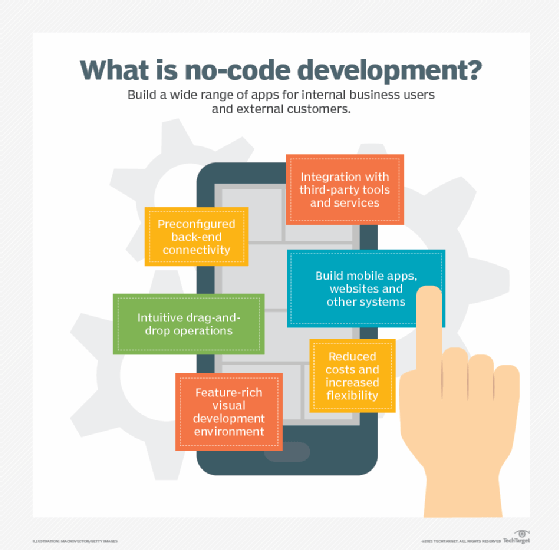Good Suggestions For Selecting Low-Code Platform Examples
Wiki Article
The Benefits Of Low-Code Development For Non-Developers In Terms Of Accessibility
Low-code apps improve accessibility by non-developers (often called "citizen-developers") due to certain key aspects.
Drag-and-Drop Builders: Low-code systems offer drag-and-drop interfaces that allow non-developers to design applications without having to write code. This makes the process of developing easier for people with technical background.
WYSIWYG: WYSIWYG editors are "What you see is what you get" editors that allow users to design workflows and interfaces that are similar as the final product. It makes it much simpler to use and understand.
Simplified Workflow and Logic Design:
Visual Workflow Modelling: Users can use visual workflow to design business processes, applications logic and flowcharts using diagrams and visually-designed flowcharts. These methods are more intuitive than the traditional coding methods.
Pre-built Logic components: Low-code platforms include logic components that are pre-built (e.g. conditional statements and loops) and can be configured easily which eliminates the need for complicated coding.
Reusable Templates and Components:
Library of pre-built templates: Many Low-Code platforms have templates based on common application types. Non-developers are able to customize these templates, if required.
Reusable widgets and modules : By using reusable widgets or modules users can speed up the creation process by eliminating the need for extensive technical knowledge.
Guided Development and Tutorials
Step-by step guides Platforms offer tutorials, tips on screen, and guided development paths to assist developers who are not experts in developing applications.
Interactive Tutorials: Interactive, hands-on tutorials allow users to learn through doing, improving their understanding and confidence in using the platform.
Integration with Tools Already in Use:
Easy integration Low-code platforms are created to be able to seamlessly integrate with existing business systems and tools (e.g. ERP, CRM) permitting non-developers to create applications in their existing workflows.
APIs and Connectors: APIs built-in and connectors let non-developers and users to easily connect applications to external services, without the need to write complex coding.
Collaboration Features:
Team Collaboration: Features like real-time collaboration, as well as shared workspaces enable non-developers to work alongside professionals, business analysts and other stakeholders efficiently.
Role Based Access Control: You can assign non-developers roles that correspond to the appropriate access level, so that they can participate in the development process without compromise on security or function.
Automated Testing and Debugging
Low-code platforms are often equipped with testing and debugging software that automatizes these processes. This makes it easier for non-developers to check their applications work correctly.
Error-highlighting: The platform points out problems and offers solutions to guide non-developers.
Low-code development is more accessible to non-developers as it makes development more accessible to everyone. Low-code applications allow business users to be involved in the creation and maintenance of applications through the use of intuitive visual tools and a guided user experience. This bridges the gap between the technical implementation and business requirements. Check out the top Low-code Platform for application development for site advice including stored sql procedures, azure sql server, microsoft azure sql, microsoft azure sql, stored sql procedures, cross platform mobile app development, cross platform mobile development, app modernization, stored sql procedures, ms azure sql and more.

Low-Code Apps Are Affordable.
Low-code applications offer a variety of advantages in terms of cost-effectiveness. Companies seeking to reduce costs are able to benefit from this method while still delivering high-quality applications. The main benefits are: Reduced development costs:
Less Coding Needed: Low-code platform eliminates the need for long manual code. This saves time and effort of developers in developing their applications. This translates into less labor costs.
We require fewer resources for developers. Programming low-code is easier and faster and therefore fewer developers with specialized skills are required. This will drastically reduce the need for the cost of hiring and staffing.
More Time to Market
Rapid development cycle: Visual tools for development and pre-built components provided by platforms with low-code support rapid design of applications, which allows companies to get their products on the market quicker. This could lead to quicker revenues and better positioning in the market.
Rapid prototyping: By developing rapid prototypes and testing them quickly, businesses can reduce the amount of time they invest in the development stage and also allow for faster iterations based on user feedback.
Lower Maintenance Costs
Due to their modularity and standard components, apps built on low-code platforms tend to be easier to maintain. This helps reduce maintenance and support cost.
Automated Updates: Many low-code platforms handle patches and updates automatically making sure that applications remain safe and up-to-date, without the need for extensive manual intervention.
Efficient Resource Utilization:
Contributions from non-developers: Low-code platforms enable both developers and business users to take part in the development process. This democratization in development allows businesses and employees to collaborate, thereby reducing the dependence on highly paid developers.
Optimized Use Of IT Resources IT teams can focus on strategic initiatives rather than getting bogged down with mundane development work, improving productivity and overall efficiency.
Scalable Pricing Models
Subscription Pricing: Many platforms that use low-code provide flexible pricing models that are based on subscriptions that are scaled depending on the usage. This gives businesses the capability to adapt their spending according to their needs and growth without having to pay large upfront costs.
Pay-Ass-You-Go Options: Certain platforms have pay-ass-you go options that guarantee businesses only pay when they make use of resources. This can be especially beneficial for small and start-up businesses with limited budgets.
Reduced costs of third-party software:
Low-code platforms come with built-in functionality and integrations that can reduce the cost of software subscriptions and licensing.
Pre-Built Integrations: The existence of pre-built integrations for popular systems and services reduces the need for custom development, thereby saving time and money.
Improved ROI
Faster Return on Investment: The combination of rapid development, less expensive and a faster time to market mean that companies can achieve a faster return on investment (ROI) for their apps.
Increased Agility: Businesses are able to quickly adapt to market changes and the needs of customers, ensuring that they stay current and take advantage of emerging opportunities when they occur.
Lower Training Costs:
User-Friendly Interfaces: The intuitive interfaces and user-friendly features offered by low-code platforms reduce the learning curve thereby making it less necessary to conduct extensive training.
Accessible Resources Low-Code Platforms: Many low-code platforms have comprehensive instructional materials, tutorials and support for community members, thereby lessening the need for formal training and the associated expenses.
Collaboration can be made easier.
Enhanced Collaboration Tools : The collaboration tools integrated into the software facilitate collaboration and communication between team members. This leads to an efficient development process as well as lower costs.
Unified Development Environment (UDE): A single, unified development environment streamlines workflows, reducing the costs and complexity of managing various tools and platforms.
In general, low-code apps cost less due to their ability to lower costs for development and maintenance, to accelerate time-to-market, to maximize resource use, and to provide flexibility in pricing. These elements provide substantial financial benefits to business which makes low-code development an appealing option for companies who want to make the most of their budgets and achieve solid, reliable, high-quality applications. See the top rated Enterprise application development with Low-code Platform examples for site info including cross platform mobile dev, app modernisation, app dev platform, rad application development, cross platform app development, rapid app development, software for app development, sso azure, rapid action development, push notifications android and more.

The Benefits Of Low-Code Development To Collaborate And Streamline Workflow
Low-code app development is an excellent option for companies looking to increase team efficiency by streamlining the development process. Here are the major advantages: Improved Collaboration Across Functions:
Unified Development Environment: Low-code platforms provide a single, unified environment where all team members, including business analysts, developers designers, and stakeholders, can collaborate effectively. This helps reduce the number of silos, as well as improves communication.
Visual Development Tools - The drag and drop visual nature of low code platforms allows for non-technical staff to easily participate in the process. This makes sure that all business requirements are identified and accurately implemented.
Communication Enhanced
Real-Time Collaboration Many low-code platforms offer real-time capabilities, like commenting and editing simultaneously, or immediate feedback. This allows for continuous communication, and helps decrease the time that is spent in back-and forth discussions.
Workspaces shared by teams are able to work in tandem on shared workspaces in which they edit and discuss the project's elements. This ensures that everyone is working towards the same goal and is on the exact same team.
Streamlined Workflow:
Built-in Project Management Tools: Low-code platforms usually include integrated software for managing projects that help teams plan, track, control, and coordinate their development projects. This includes assigning tasks, progress tracking as well as deadline management.
Workflow Automation - Automating routine tasks or workflows permits teams to concentrate their efforts on more strategic initiatives and tasks and improves the overall efficiency of the organization.
Speedier Iteration Cycles:
Rapid prototyping. Low-code platforms allow rapid prototyping. This ensures feedback can be quickly integrated and improvements are made.
Support for agile development: Supporting agile methods allows teams to be continuously working in sprints. This makes it simpler to adjust and provide small steps to improve capabilities.
Accessibility:
Citizen development: Low-code platforms allow business users to modify and develop applications without extensive programming knowledge. This allows IT and development teams to concentrate on other tasks and respond faster to business requirements.
Training and Onboarding - Intuitive interfaces, comprehensive training resources and intuitive interfaces make it easier for new team members to get up to speed and improve the overall team's cooperation.
Centralized documentation knowledge sharing, dissemination and documentation:
Integrated Documentation : Low-code platforms offer a wide range of tools that allow for the creation and maintaining of documentation on the platform. This will ensure that all information related to the project is easily accessible and located centrally.
Knowledge Repositories: Teams are able to develop and maintain knowledge repositories that include best practices, templates, and reusable components, facilitating knowledge sharing and reducing duplicate work.
Consistency and uniformity:
Standardized Components. Standardization of components across different applications ensures consistency, which makes it easier to work and understand the team members.
Compliance and governance: Built-in frameworks for governance assure that all applications are designed in accordance to organizational standards, regulatory requirements and standards for quality. They minimize the chance of not being compliant and ensure that the applications are compliant with standards.
Feedback and Improvement:
Integrated Feedback Systems: Low code platforms have integrated feedback systems that permit users to give feedback about the application. The feedback can then be used in the development of these applications.
Continuous Improvement: The ability to rapidly test and deploy changes based on feedback assures the continuous improvement of apps which are aligned with user needs and business objectives.
Visualization and Reporting
Real-Time Analyses: The built-in reports and analytics tools offer instantaneous insight into the project's performance, development and user interactions, making it possible for data-driven decisions.
Visual Workflow Analysis: Visual tools are used to visualize workflows and processes. These tools aid teams to analyze and improve their workflows.
Low-code development can offer many benefits in regards to workflow and collaboration. It allows for the integration of diverse teams together, automate processes, improve communication, and boost collaboration. This helps create a more agile, efficient and collaborative environment for development, which ultimately results in better-quality applications and better alignment of business goals.
